
PUMPA - SMART LEARNING
எங்கள் ஆசிரியர்களுடன் 1-ஆன்-1 ஆலோசனை நேரத்தைப் பெறுங்கள். டாப்பர் ஆவதற்கு நாங்கள் பயிற்சி அளிப்போம்
Book Free DemoComponents of Hydrologic Cycle
There are six main components in the hydrologic cycle. They are:
1) Evapotranspiration
2) Condensation
3) Precipitation
4) Infiltration
5) Percolation and
6) Runoff
Evapotranspiration
Evapotranspiration = Evaporation + Transpiration
It can be defined as the total loss of water from the earth through both evaporation from the surface water bodies and the transpiration from vegetation.
It can be defined as the total loss of water from the earth through both evaporation from the surface water bodies and the transpiration from vegetation.
In the agricultural fields, it is difficult to determine evaporation and transpiration separately. Therefore, it is collectively called evapotranspiration.
Evaporation
Evaporation is a process in which liquid water changes into water vapour below its boiling point.
Water boils at \(100\)°C (\(212\)°F or \(373K\)) temperature but, evaporation may even begin at \(0\)°C (\(32\)°F or \(273K\)), and the process is very slow. Temperature is the prime factor that affects the rate of evaporation. The rate of evaporation is directly proportional to the temperature, i.e. with an increase in temperature, the rate of evaporation also increases and vice versa.
Some of the other factors that affect the rate of evaporation are the areal extent of surface water, wind, and atmospheric humidity. Many studies reveal that \(90\)% of the moisture in the atmosphere comes from the oceans, seas, lakes and rivers through evaporation, and plants contribute the remaining \(10\ \)% through transpiration.
On a global scale, there is a good balance between the amount of water that gets evaporated and the amount of water delivered to earth as precipitation. But, the amount of evaporation varies geographically, as evaporation is more prevalent over the oceans than precipitation, whereas over the land, precipitation routinely exceeds evaporation.

The rate of evaporation is also dependent on the wind speed, i.e. the evaporation rate is low during periods of calm winds compared to windy times. So we may conclude that the rate of evaporation is directly related to the wind speed.
When the air is calm, evaporated water tends to stay close to the water body, preventing further evaporation because of the existing water content in the air. But, During windy times, the water vapour is driven away and is replaced by the fresh influx of dry air, which facilitates additional evaporation.
The rate of evaporation increases with
• Increase in wind speed
• Increase in temperature
• Decrease in humidity and
• Increase in areal extent of surface water bodies
• Increase in wind speed
• Increase in temperature
• Decrease in humidity and
• Increase in areal extent of surface water bodies
Transpiration is the process in which plant roots absorb water and then release the water in the form of vapour through the leaves.
In other words, Transpiration is the evaporation of water through minute pores, or stomata, in the leaves of plants. Much of the water taken up by plants is released through transpiration.
Factors like temperature, wind and humidity also affect the rate of transpiration. Transpiration rate also varies with soil water content and the ability of the soil to conduct water to the roots, the nature of the plant parts, including barks and leaves. In the case of agriculture, the crop characteristics, its environment and cultivation practices also affect the transpiration process.